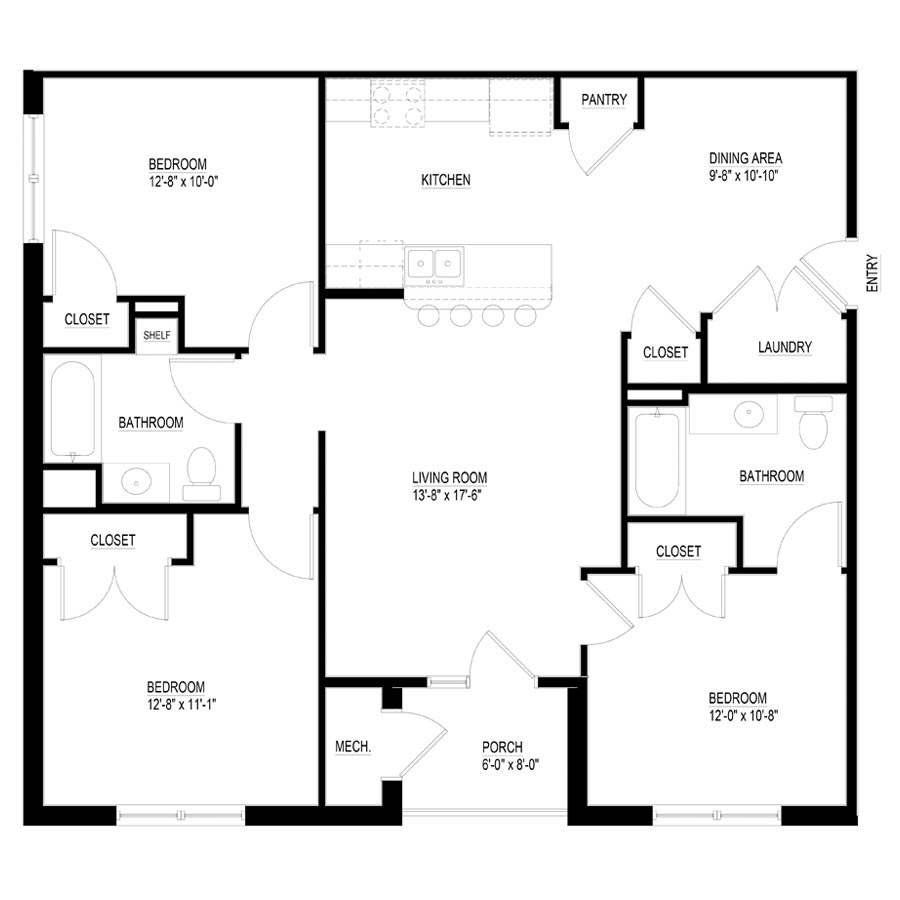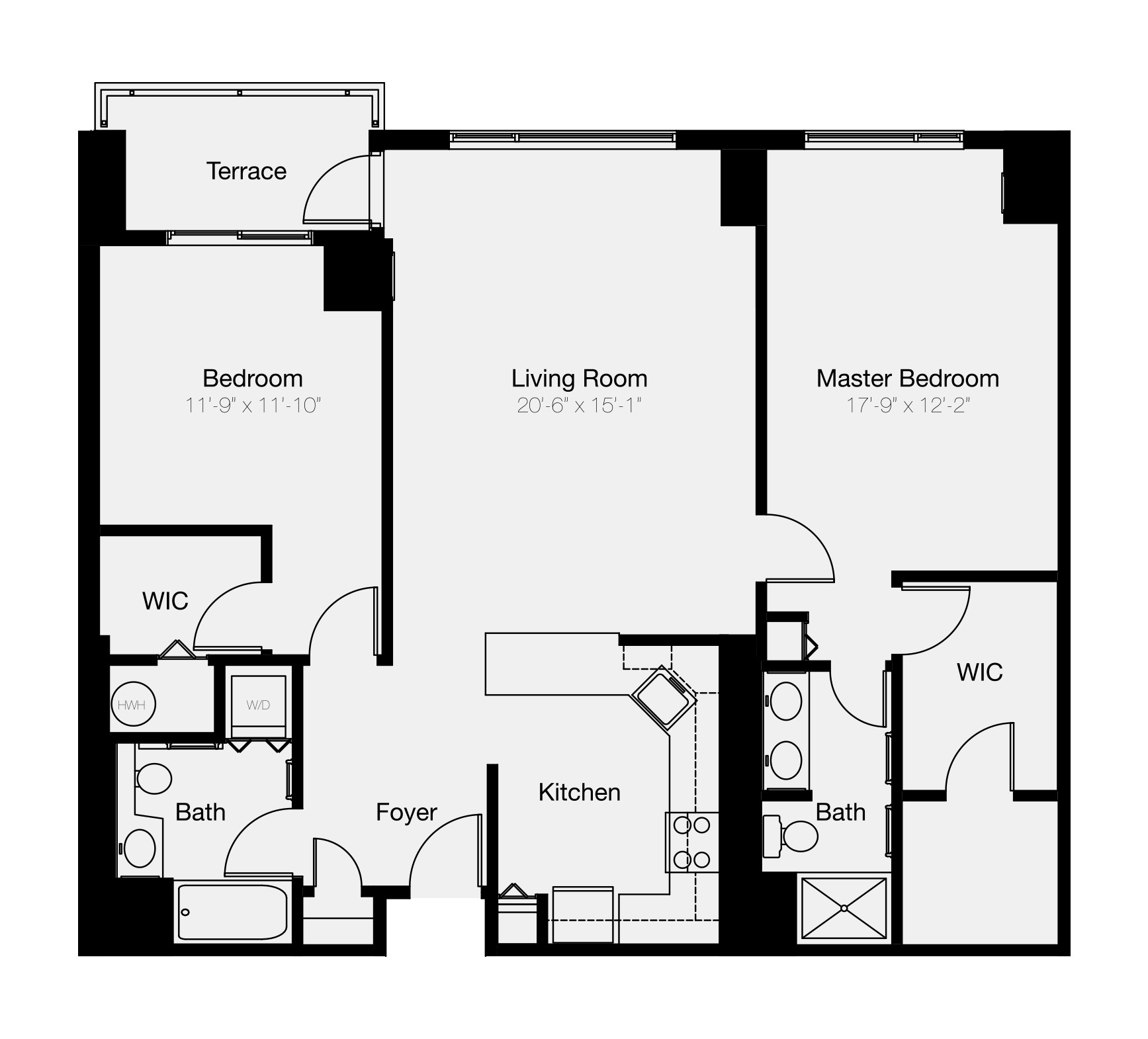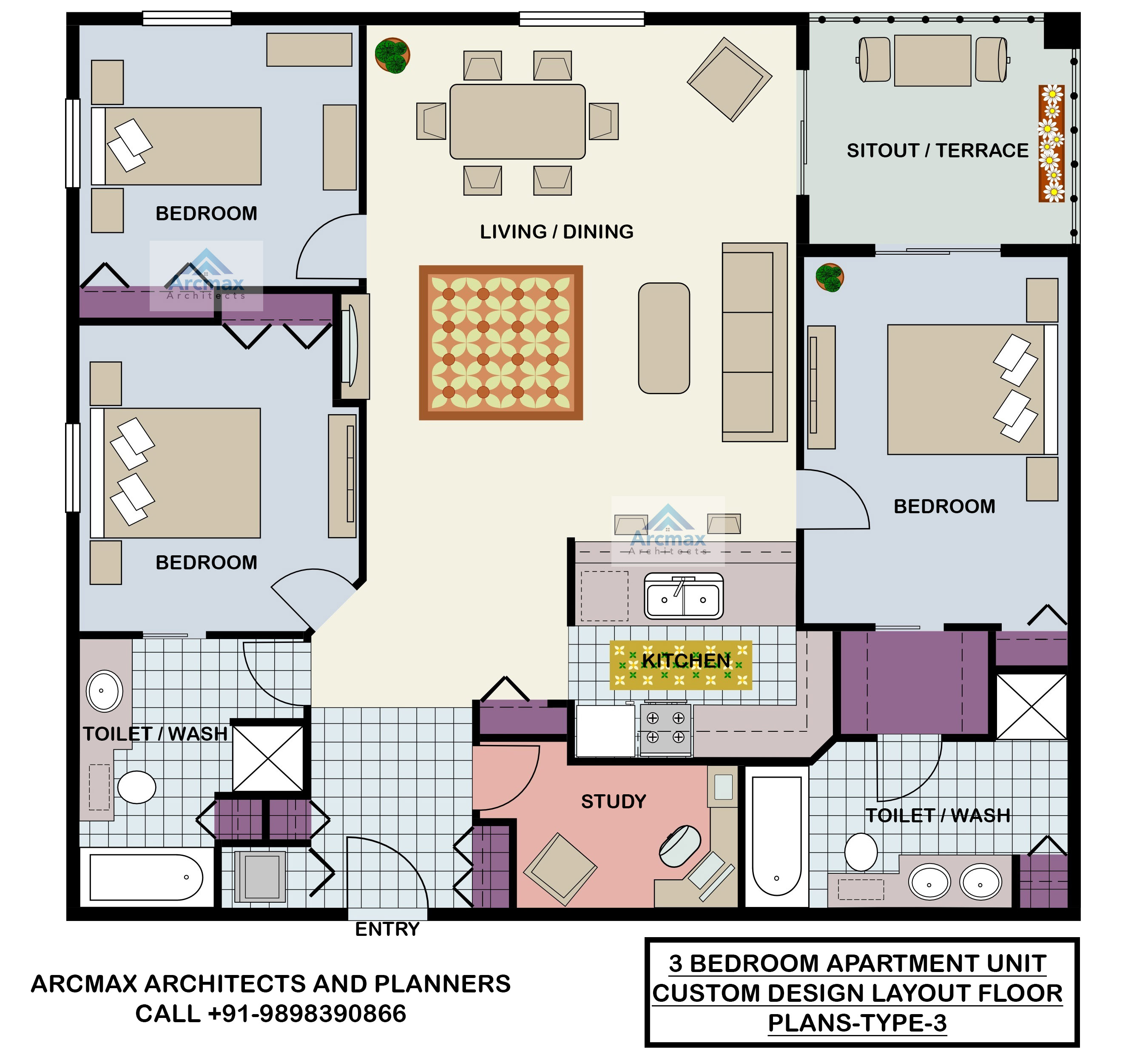Understanding 3 Bedroom Condominium Floor Plans

A 3-bedroom condominium floor plan offers a versatile living space suitable for families, individuals seeking extra space, or those who enjoy having a dedicated workspace or guest room. The layout of a 3-bedroom condominium can vary significantly, impacting the overall functionality and flow of the space.
Types of 3-Bedroom Condominium Floor Plans
The design of a 3-bedroom condominium floor plan can influence its functionality, aesthetics, and space utilization. Some common types of 3-bedroom condominium floor plans include:
- Open Concept: This type of floor plan prioritizes an open and airy feel by merging the living, dining, and kitchen areas. The absence of walls creates a spacious and social atmosphere, ideal for entertaining and maximizing natural light.
- Traditional: Traditional floor plans emphasize distinct and defined spaces, featuring separate rooms for living, dining, and kitchen areas. This layout provides privacy and structure, making it suitable for families who value distinct zones for different activities.
- Split-Level: This type of floor plan divides the living space into different levels, often with the bedrooms situated on a separate level from the living and dining areas. Split-level floor plans can offer a unique layout, creating distinct zones for different activities and enhancing privacy.
Advantages and Disadvantages of Different Floor Plans
The choice of a 3-bedroom condominium floor plan depends on individual preferences and lifestyle. Each type offers distinct advantages and disadvantages in terms of space utilization, functionality, and aesthetics.
- Open Concept:
- Advantages: Creates a spacious and airy feel, maximizes natural light, ideal for entertaining and social gatherings, allows for flexible furniture arrangements.
- Disadvantages: Can lack privacy, may be challenging to create distinct zones for different activities, can be noisy, may require more furniture to define different areas.
- Traditional:
- Advantages: Provides privacy and structure, allows for distinct zones for different activities, offers a more formal and traditional feel, can be easier to manage noise levels.
- Disadvantages: Can feel cramped and less spacious, may limit natural light, can be less flexible for furniture arrangements, may require more furniture to create distinct zones.
- Split-Level:
- Advantages: Offers a unique and interesting layout, creates distinct zones for different activities, enhances privacy, can be more efficient for space utilization.
- Disadvantages: Can be challenging to navigate, may not be suitable for individuals with mobility limitations, can be difficult to furnish efficiently, may limit natural light.
Common Layouts for 3-Bedroom Condominiums
The layout of a 3-bedroom condominium can vary significantly, depending on the building’s design and the developer’s vision. Some common layouts include:
- Master Bedroom Suite: This layout features a spacious master bedroom with an en-suite bathroom and walk-in closet. This provides a private and luxurious space for the primary residents. The other two bedrooms can be used as guest rooms, children’s rooms, or home offices.
- Guest Rooms: The layout includes two guest rooms, often with shared access to a bathroom. This is ideal for families who frequently host guests or have visiting relatives. The third bedroom can be used as a home office, hobby room, or a playroom for children.
- Multi-Purpose Rooms: This layout often features a larger bedroom that can be used for various purposes, such as a home office, guest room, or a playroom. The other two bedrooms are standard-sized and can be used as guest rooms or children’s rooms.
Key Features and Considerations: 3 Bedroom Condominium Floor Plans

Choosing a 3-bedroom condominium floor plan involves careful consideration of various factors that impact functionality, comfort, and overall living experience. Beyond the number of bedrooms, a comprehensive assessment of key features and considerations ensures a well-informed decision that aligns with individual needs and preferences.
Square Footage and Room Sizes
The total square footage of a condominium unit provides a general indication of its overall size, but a closer examination of individual room sizes is crucial. Adequate square footage ensures sufficient space for furniture, movement, and overall comfort.
- Living Area: The living room should be spacious enough to accommodate comfortable seating, entertainment systems, and potentially a dining area.
- Bedrooms: Each bedroom should provide ample space for a bed, dresser, and other essential furniture. Consider the size of the bedrooms in relation to the number of occupants and their needs.
- Kitchen: The kitchen layout should be functional and efficient, with sufficient counter space, storage, and appliances that meet individual cooking needs.
- Bathrooms: The size and layout of bathrooms should be practical, with adequate space for a shower or bathtub, toilet, and vanity.
Closet Space and Storage
Adequate closet space and storage options are essential for maintaining a tidy and organized living environment.
- Walk-in Closets: Large walk-in closets in the master bedroom provide ample storage for clothing, shoes, and accessories.
- Built-in Storage: Built-in shelving, cabinets, and drawers in bedrooms, hallways, and other areas offer organized storage solutions.
- Pantry: A dedicated pantry provides ample storage for groceries and kitchen supplies.
Natural Light and Ventilation
Natural light and proper ventilation are crucial for a healthy and comfortable living environment.
- Window Placement: The placement and size of windows significantly impact natural light and ventilation. Floor plans with large windows and strategically positioned windows that maximize natural light and air circulation are desirable.
- Balconies and Patios: Balconies or patios provide additional outdoor space for relaxation and fresh air.
Accessibility Features
Accessibility features are becoming increasingly important in floor plan design, ensuring that the unit is comfortable and usable for people of all abilities.
- Wide Doorways: Wide doorways and hallways provide ample space for wheelchair access and maneuverability.
- Grab Bars: Grab bars in bathrooms and showers offer additional support and safety.
- Lowered Countertops: Lowered countertops in the kitchen and bathroom make it easier for people with mobility challenges to access and use these spaces.
Building Codes and Regulations, 3 bedroom condominium floor plans
Building codes and regulations play a crucial role in ensuring the safety, functionality, and accessibility of condominium floor plans.
- Fire Safety: Building codes mandate fire safety features such as fire alarms, sprinklers, and fire escapes.
- Electrical and Plumbing: Codes govern the installation and placement of electrical wiring, plumbing, and other essential utilities.
- Accessibility Standards: Accessibility codes require certain features to be incorporated into floor plan designs to ensure accessibility for people with disabilities.
Design and Functionality

The design and functionality of a 3-bedroom condominium floor plan are crucial aspects to consider when purchasing or renting a property. They influence the overall living experience, affecting space utilization, convenience, and aesthetic appeal.
Sample 3-Bedroom Condominium Floor Plan
A sample 3-bedroom condominium floor plan can be envisioned as follows:
– Living Room (15′ x 20′): This spacious living area is located at the front of the unit, providing a welcoming entry point and a dedicated space for relaxation and entertaining guests.
– Kitchen (10′ x 12′): Adjacent to the living room, the kitchen features a well-designed layout with ample counter space, cabinets, and appliances for preparing meals.
– Dining Area (10′ x 10′): This area is seamlessly integrated with the kitchen, providing a dedicated space for dining.
– Master Bedroom (12′ x 15′): The master bedroom is a private retreat with an ensuite bathroom and walk-in closet.
– Bedroom 2 (10′ x 12′): This bedroom offers comfortable living space for a guest or child.
– Bedroom 3 (10′ x 12′): This bedroom can serve as a home office, guest room, or a child’s bedroom.
– Bathroom 1 (6′ x 8′): The ensuite bathroom attached to the master bedroom features a shower and vanity.
– Bathroom 2 (5′ x 7′): This bathroom is located near the bedrooms and features a bathtub and vanity.
– Hallway (4′ x 15′): The hallway connects all the rooms, providing a convenient passageway.
– Balcony (5′ x 10′): The balcony offers a private outdoor space for relaxation and enjoying the views.
Types of 3-Bedroom Floor Plan Designs
Different 3-bedroom floor plan designs cater to various preferences and lifestyles. Here is a table showcasing some common designs with their corresponding advantages and disadvantages:
| Design Type | Advantages | Disadvantages |
|—|—|—|
| Open Concept | Maximizes space and natural light, promotes a sense of openness and flow | Can be noisy and lack privacy |
| Traditional | Offers defined spaces for each room, providing privacy and a sense of order | Can feel cramped and outdated |
| Split-Level | Creates distinct living areas on different levels, offering privacy and separation | Can be challenging for individuals with mobility issues |
| Loft | Features high ceilings and open spaces, offering a modern and industrial feel | Can be difficult to heat and cool, may lack privacy |
Room Functionalities in a 3-Bedroom Condominium
Understanding the functionality of each room within a 3-bedroom condominium is essential for maximizing its potential.
Bedrooms
Bedrooms are the private spaces for sleeping, relaxing, and personal activities.
Bathrooms
Bathrooms provide essential amenities for hygiene and grooming.
Living Spaces
Living spaces, such as the living room and dining area, serve as social hubs for entertaining guests, family gatherings, and relaxation.
Kitchens
Kitchens are the heart of the home, facilitating food preparation, cooking, and dining.
3 bedroom condominium floor plans – Three bedroom condominium floor plans offer a canvas for creating your personal sanctuary. Imagine a spacious master suite with a luxurious en suite bathroom, perhaps featuring a calming gray bathroom with oil rubbed bronze fixtures , reflecting both elegance and serenity.
With the right vision, every corner of your three-bedroom condo can become a space for rejuvenation and growth.
When envisioning a 3 bedroom condominium floor plan, consider the details that elevate your living experience. From the layout of each room to the flow of the entire space, every element plays a role in creating a harmonious environment. Even seemingly small details, like the bathroom door pull handles , contribute to the overall aesthetic and functionality.
Remember, a home is a sanctuary, and thoughtful choices, like those involving the design of your condominium floor plan, can create a space that nurtures your spirit and fosters a sense of well-being.